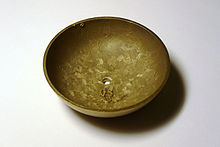Bronze is an alloy that consists primarily of copper with the addition of other ingredients. In most cases the ingredient added is typically tin, but arsenic, phosphorus, aluminum, manganese, and silicon can also be used to produce different properties in the material. All of these ingredients produce an alloy much harder than copper alone.. Bronze is of exceptional historical interest and still finds wide applications. It was made before 3000 BC, though its use in artifacts did not become common until much later. The proportions of copper and tin varied widely (from 67 to 95 percent copper in surviving artifacts), but, by the Middle Ages in Europe, certain proportions were known to yield specific properties. An alloy described in an 11th-century Greek manuscript in the library of St. Mark’s, Venice, cites a proportion of one pound copper to two ounces of tin (8 to 1), approximately that used for bronze gunmetal in later times. Some modern bronzes contain no tin at all, substituting other metals such as aluminum, manganese, and even zinc.

Bronze is harder than copper as a result of alloying that metal with tin or other metals. Bronze is also more fusible (i.e., more readily melted) and is hence easier to cast. It is also harder than pure iron and far more resistant to corrosion. The substitution of iron for bronze in tools and weapons from about 1000 BC was the result of iron’s abundance compared to copper and tin rather than any inherent advantages of iron.
Bell metal, characterized by its sonorous quality when struck, is a bronze with a high tin content of 20–25 percent. Statuary bronze, with a tin content of less than 10 percent and an admixture of zinc and lead, is technically a brass. Bronze is improved in hardness and strength by the addition of a small amount of phosphorus; phosphor bronze may contain 1 or 2 percent phosphorus in the ingot and a mere trace after casting, but its strength is nonetheless enhanced for such applications as pump plungers, valves, and bushings. Also useful in mechanical engineering are manganese bronzes, in which there may be little or no tin but considerable amounts of zinc and up to 4.5 percent manganese. Aluminum bronzes, containing up to 16 percent aluminum and small amounts of other metals such as iron or nickel, are especially strong and corrosion-resistant; they are cast or wrought into pipe fittings, pumps, gears, ship propellers, and turbine blades.

Besides its traditional use in weapons and tools, bronze has also been widely used in coinage; most “copper” coins are actually bronze, typically with about 4 percent tin and 1 percent zinc.
CREDIT: Encyclopædia Britannica, Inc.
ORIGINAL FROM: https://www.britannica.com/technology/bronze-alloy


 China
China